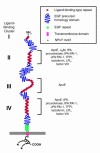LRP: a multifunctional scavenger and signaling receptor
- PMID: 11560943
- PMCID: PMC200939
- DOI: 10.1172/JCI13992
LRP: a multifunctional scavenger and signaling receptor
Figures


References
-
- Willnow TE, Nykjaer A, Herz J. Lipoprotein receptors: new roles for ancient proteins. Nat Cell Biol. 1999;1:E157–E162. - PubMed
-
- Herz J, Beffert U. Apolipoprotein E receptors: linking brain development and Alzheimer disease. Nat Rev Neurosci. 2000;1:51–58. - PubMed
-
- Goldstein, J.L., Hobbs, H.H., and Brown, M.S. 2001. Familial hypercholesterolemia. In Metabolic and molecular bases of inherited disease. C.R. Scriver et al., editors. McGraw-Hill Publishing Co. New York, New York, USA. 2863–2913.
-
- Neels JG, et al. The second and fourth cluster of class A cysteine-rich repeats of the low density lipoprotein receptor-related protein share ligand-binding properties. J Biol Chem. 1999;274:31305–13311. - PubMed
-
- Springer TA. An extracellular beta-propeller module predicted in lipoprotein and scavenger receptors, tyrosine kinases, epidermal growth factor precursor, and extracellular matrix components. J Mol Biol. 1998;283:837–862. - PubMed
Publication types
MeSH terms
Substances
Grants and funding
LinkOut - more resources
Full Text Sources
Other Literature Sources
Miscellaneous

